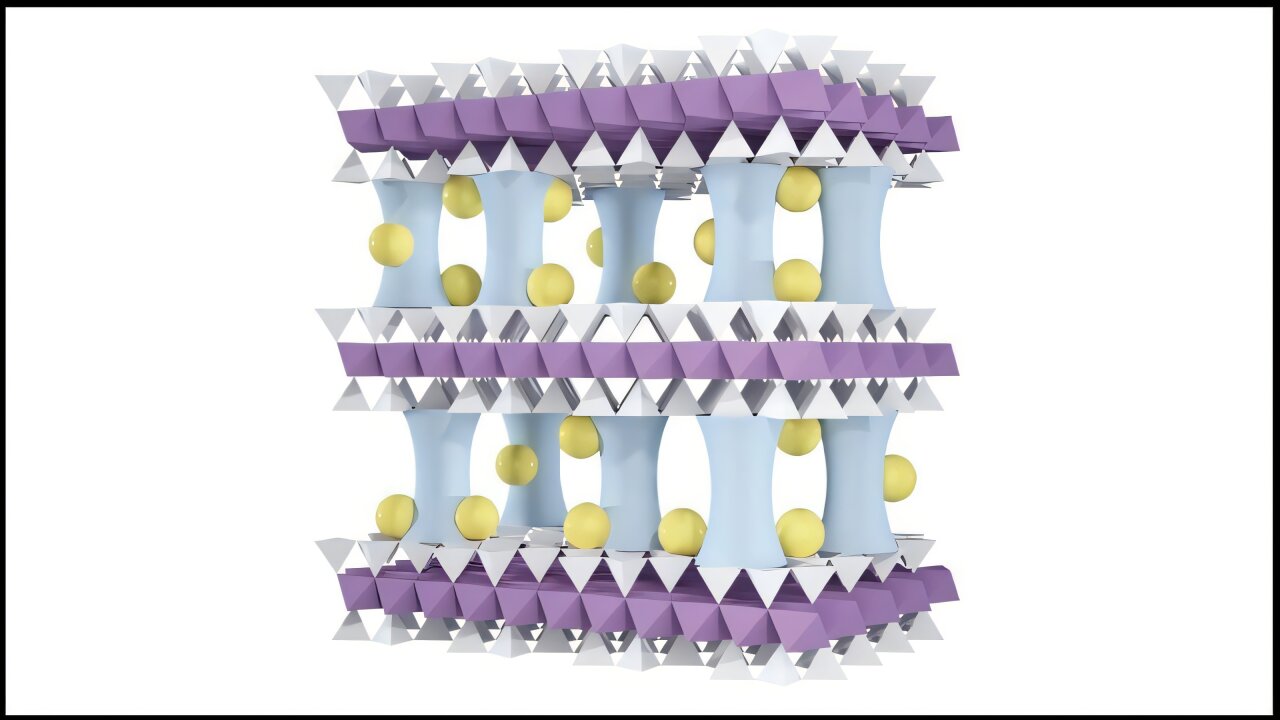
Atomic structure of vermiculite membrane showing 2D layers supported by aluminum oxide pillars. Yellow Balls are Doped Sodium Ion. Credit: Argonne National Laboratory
Lithium, the lightest metal on the periodic table, plays a Pivotal Role in Modern Life. Its low weight and high energy density makes it ideal for electric vehicles, cellphones, laptops and Military Technologies from where every outs countes. As Demand for Lithium Skyrockets, Concerns about Supply and Reliability are growing.
To help meet surlying demand and possible supply Chain Problems, Scientists at the US Department of Energy’s (Doe) Argonne National Laboratory Have Developed An Innovative Membrane Tchnology Efficiently Extracts Lithium from Water. Several Team Members also Hold Joint Appointments With the Pritzker School of Molecular Engineering (PME) at the University of Chicago.
The findings appear in the journey Advanced Materials,
“The new membrane we have developed offers a potential low-cost and abundant alternative for Lithium extraction here at home,” Said Seth Darling, CHEF SCIEF SCIENTING, Chafe Science and Technology Offer for ARGONNES Advanced Energy Technologies Directorate. He is also director of the advanced materials for energy-water system
Right now, Most of the World’s Lithium Comes from Hard-Rock Mining and Salt Lakes in just a more Countries, Lending Supply Chains Vulnerable to Disruption. Yet Most of the Earth’s Lithium is actually disasolved in seawater and underground salt salt water reserve.
The problem? Extracting it from these unconventional sources have been prohibitively expensive, energy-hungry and intelligence. Traditional methods Struggle to Separate Lithium from Other, More Abundant Elements Like Sodium and Magnesium.
In salt water, lithium and other elements exist as cations. These are atoms that have lost one or more electrons, giving them a positive electric charge. The key to Efficient Lithium Extraction Lies in Filtering Out the other cations based on bot size and degree of charge.
The new membrane offers a promising low-cost solution. It’s made from vermiculite, a naturally abundant clay that costs only about $ 350 per ton. The team developed a process to peel apart the Clay Into Ultrathin Layers – Just a billionth of a meter thick –nd then restack them to form a kind of filter. These layers are so thin they’re consides 2D.
But there was a hit: untred, the Clay layers Fall Apart in Water Within Half An Hour Due to Their Strong Affinity to it.
To solve this problem, Researchers Inserted Microscopic Aluminum Oxide Pillars Between the layers, giving the structure the look of a high-rest robbing lot under construction-with pilling each “Floor” in place. This Architecture Prevents Collapse While Neutralizing The Membrane’s Negative Surface Charge, a Crucial Step for Subsequent modifications.
Next, Sodium cations was into introduced into the membrane, where they settled Around the aluminum oxide pillars. This changed the membrane’s surface charge from neutral to positive. In water, both magnesium and lithium ieons carry a positive charge, but magnesium ieons carry a higher charge (+2) compared with lithium ions (+1).
The membrane’s positively charged surface reepels the higher-critical magnesium Ions more for forr forcefully This Difference allows the membrane to capture lithium Ions more Easily While Keeping Magnesium Ions Out.
To further refine performance, the team added even more Sodium Ions. This decreased the membrane’s pore size. The result is that the membrane allows the smaller ieons like Sodium and Potassium to Pass Through While Catching The Larger Lithium Ions.
“Filtering by bot ion size and charge, our membrane can pull lithium out of water with much greater efficiency,” said first author yining liu, a ph.d. Candidate at uchicago and a member of the amws team. “Such a Membrane Blad Reduce Our Dependence on Foreign Suppliers and Open the Door to New Lithium Reserves in Places We Never Considered.”
The Researchers Believe This Breakthrough has broader applications, from recovering other key materials like nickel, cobalt and rare earth elements, to removing harmoving harmful contests from water Supplies.
“There are many types of this Clay Material,” said liu. “We’re exploring how it might help collect critical elements from seawater and salt lake brines or even help clean up our drinking water.”
More information:
Yining liu et al, pillarred laminar vermiculite membranes with tunable monovalent and multivalent ion selectivity, Advanced Materials (2025). Doi: 10.1002/adma.202417994
Citation: Ultrathin Clay Membrane Layers Offer Low-Cost Alternative for Extracting Lithium from Water (2025, July 10) Retrieved 10 July 2025 from https://techxplore.com/news/2025-07-ltrathin-mmbrane-layers- alternative.html
This document is Subject to copyright. Apart from any Fair Dealing for the purpose of private study or research, no part may be reproduced without the written permission. The content is provided for information purposes only.



